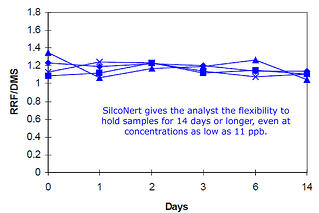
With major Tier 3 capital projects in the works it's easy to forget one important aspect of compliance, the sampling system. The lower the sulfur detection limit, the greater the impact reactive sample flowpath surfaces will have on sulfur loss. What was thought to be a minor source of sulfur adsorption/loss under Tier 2 will become a major issue under Tier 3. The impact of a single adsorption site under Tier 3 could be the difference between compliance and a significant increase in sulfur content in gasoline.
Inert SilcoTek® coatings are a major asset in achieving Tier 3 refinery compliance because they assure your sample flowpath delivers exactly what you're sampling. Inert coatings like SilcoNert® 2000 and Dursan® don't allow sulfur and other reactive substances to stick to stainless steel surfaces.

The Old Sulfur Management Ways Won't Cut It.
Hoping to avoid coating sample flowpaths because you don't want the hassle or cost? Prepare for major sample system headaches. The sampling methods used for 30 to 50 ppm sensitivity most likely will not produce meaningful results at 10 ppm and below. Here why, active sites will make up a larger portion of test error as detection limits decrease. For example, a sample flowpath that adsorbs say 1ppm of sulfur will result in only a 2% error at 50ppm levels, but for a 2ppm low side calibration, that 1ppm loss will result in, you guessed it, a 50% calibration error. That does not sound like a fun problem to fix. Inert coatings won't fix all problems associated with low level sulfur analysis but they can help eliminate adsorption related test errors in critical flowpaths.
Here are a few no-no's that won't cut it when sampling low level sulfurs:
1. Priming? Forget it. At 10ppm an uncoated sample flowpath will adsorb active compounds 'till the cows come home before you get a signal. (Also don't allow cows in refineries)
2. Uncoated fittings? One uncoated fitting will adsorb and desorb a significant amount of H2S, making calibration a nightmare.
3. Rusty sample cylinders? Active compounds will be adsorbed by rust particles, making sampling an exercise in futility.
4. Steam cleaning with dirty steam? Particulates in steam will drop out in sample system flowpaths and adsorb active sample compounds. Another source of futility.
5. Untreated filters? Fritted filters have a huge surface area. Not coating that filter will result in adsorption of most if not all of a low side calibration sample.
6. Uncoated regulators? Even components with a brief exposure to the sample will impair test quality.
7. Uncoated analyzer tubing. Just a few inches of uncoated stainless steel tubing can result in loss of sample.
Why take the risk? SilcoNert® 2000 and Dursan® are proven to improve sensitivity and response. Coating the entire sampling flowpath will assure compliance and allow operators to focus on operations, not troubleshooting an unreliable system.
Ultimate inertness
SilcoNert® 2000 prevents adsorption of H2S and other compounds in sample cylinders, tubing and other sampling surfaces. In fact SilcoNert is so effective in preventing H2S loss that samples can be stored for 14 days or longer without loss of sample integrity. Without SilcoNert, the sample would be completely adsorbed into the stainless steel sample cylinder within hours.(Data source: Restek Corp.)

Incomparable response
The old adage, do you want it right or do you want it now has been turned on it's head. SilcoTek coatings allow operators to get the sample right and now!

Response time through SilcoNert® coated tubing is reduced to seconds compared to hours for uncoated tubing. A near zero adsorption surface allows refiners, coal operators, and oil & gas professionals to immediately assess and correct for changing process conditions. Failure to react in a timely manner can cost refiners and other operators millions in shutdown costs or product quality issues.






